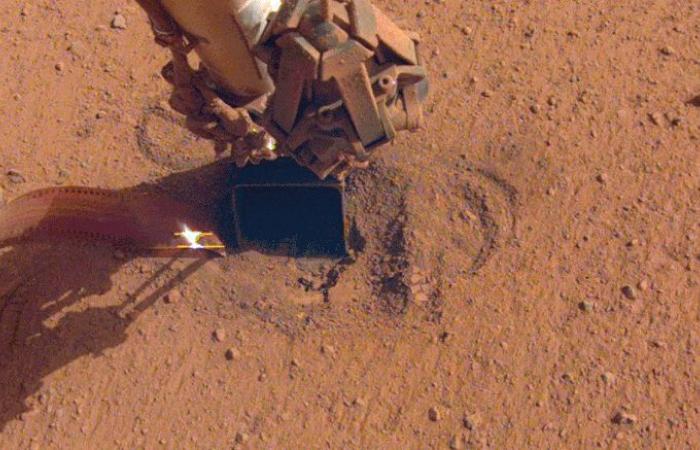NASA’s InSight retracted its robotic arm on October 3, 2020, revealing where the spiky “mole” is trying to burrow into Mars. The copper-colored tape on the mole has sensors for measuring the heat flow of the planet. In the coming months, the arm will scrape and pound the soil on the mole to help it dig. Photo credit: NASA / JPL-Caltech
Now that the thermal probe is just below the Martian surface, InSight’s arm scoops some extra soil above it so it can continue digging so it can pick up Mars,Temperature.
NASAThe InSight lander is continuing to work to bring its “mole” – a 16-inch (40-centimeter) ram and a thermal probe – deep below the surface of Mars. A camera on InSight’s arm recently captured images of the now partially filled “molehole” showing only the device’s science line sticking out of the ground.
Sensors embedded in the line measure the heat flowing from the planet as soon as the mole has dug at least 3 meters deep. The mission team worked to get the mole to dig to at least this depth so it could measure the temperature of Mars.
The mole was constructed so that loose soil flows around it, creating friction against its outer torso so it can dig deeper. Without this friction, the mole will simply jump in place as it pounds into the ground. However, the floor InSight landed on is different from what previous missions encountered: during hammering, the floor sticks together and forms a small pit around the device rather than collapsing around it and providing the friction required.
This August 19, 2019 footage shows a replica of InSight scraping soil with a shovel on the end of its robotic arm in a test lab at JPL. A replica of the “mole” – the lander’s self-pounding thermal probe – will appear when the shovel moves to the left. On Mars, InSight scrapes and pushes earth on the mole to help dig. Photo credit: NASA / JPL-Caltech
After the mole unexpectedly withdrew from the pit while pounding last year, the team placed the small shovel on the end of the lander’s robotic arm to keep it in the ground. Now that the mole is fully embedded in the soil, they will scrape extra soil over it with the shovel and push that soil off to create more friction. Since it will take months to pack enough soil, the mole is not expected to hammer again until early 2021.
“I’m very happy that we were able to recover from the unexpected ‘pop-out’ event we witnessed and get the mole deeper than ever,” said Troy Hudson, the scientist and engineer at the Jet Propulsion Laboratory NASA, who directed the work to dig the mole. “But we’re not quite finished yet. We want to make sure that there is enough soil on the mole so that it can dig on its own without the help of the arm. ”
The mole is formally referred to as a heat flow and physical property package or HP3and was built by the German Space Agency (DLR) and made available to NASA. JPL in Southern California leads the InSight mission. Read more about the mole’s latest advances on this DLR blog.
More about the mission
JPL manages InSight for NASA’s Science Missions Directorate. InSight is part of NASA’s Discovery program administered by the agency’s Marshall Space Flight Center in Huntsville, Alabama. Lockheed Martin Space in Denver built the InSight spacecraft, including the cruise stage and lander, and is supporting spacecraft operations for the mission.
A number of European partners, including the French Center National d’Études Spatiales (CNES) and the German Aerospace Center (DLR), support the InSight mission. CNES made the Seismic Experiment for Interior Structure (SEIS) instrument available to NASA together with the main researcher at IPGP (Institut de Physique du Globe de Paris). Significant contributions to SEIS came from IPGP; the Max Planck Institute for Solar System Research (MPS) in Germany; the Swiss Federal Institute of Technology (ETH Zurich) in Switzerland; Imperial College London and Oxford University in the UK; and JPL. The DLR provided the package for heat flow and physical properties (HP)3) Instrument with significant contributions from the Space Research Center (CBK) of the Polish Academy of Sciences and Astronika in Poland. The Spanish Centro de Astrobiología (CAB) supplied the temperature and wind sensors.
These were the details of the news Last but not least! NASA InSight’s “mole” is out of... for this day. We hope that we have succeeded by giving you the full details and information. To follow all our news, you can subscribe to the alerts system or to one of our different systems to provide you with all that is new.
It is also worth noting that the original news has been published and is available at de24.news and the editorial team at AlKhaleej Today has confirmed it and it has been modified, and it may have been completely transferred or quoted from it and you can read and follow this news from its main source.

